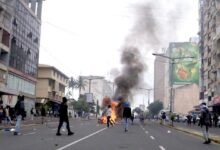Acute hunger stalks one in four people in DR Congo, warn aid agencies
 UN humanitarians warned on Thursday that one in four people in the Democratic Republic of the Congo suffers from “crisis or worse” levels of hunger that affects a staggering 25.6 million people.
UN humanitarians warned on Thursday that one in four people in the Democratic Republic of the Congo suffers from “crisis or worse” levels of hunger that affects a staggering 25.6 million people.
The alert from the Food and Agriculture Organization (FAO) and World Food Programme (WFP) follows a new dire assessment from UN-partnered food insecurity experts has shown the hunger crisis is affecting much of the vast central African nation.
The embattled east is a particular concern, where the situation is deteriorating after decades of fighting involving around 100 armed groups – including the M23 militia – who vie for control of vast natural riches, threatening regional security.
“In such a fragile context, the cost of inaction is truly unthinkable,” said Peter Musoko, WFP Country Director and Representative in DR Congo. “Together, we need to work with the Government and the humanitarian community to increase resources for this neglected crisis.’’
All-encompassing emergency
A map of DR Congo from the latest Integrated Food Security Phase Classification (IPC) report shows that almost all regions are affected by “crisis” levels of hunger – IPC3, with five indicating the highest level of danger.
A further 3.1 million mainly displaced people and returnees in northeast DR Congo are in an even worse situation – IPC4 – which is characterized by extreme food shortages, excessive levels of acute malnutrition and disease, along with a rapidly increasing risk of hunger-related death.
Tweet URL
Humanitarians are particularly concerned for vulnerable communities in the provinces of North Kivu, Ituri and South Kivu, where more than 6.5 million people are displaced. Tanganyika has also suffered intense flooding and is now the “most food-insecure” province in DR Congo.
Preventable tragedy
The humanitarian emergency is largely preventable and continues to be driven by unrelenting armed violence linked to the resource-rich east, conflict and soaring food prices, the UN agencies noted.
DR Congo “boasts fertile lands and abundant water resources and possesses the inherent capacity to attain self-sufficiency in food production”, FAO and WFP said in a joint statement.
They highlighted that the country had been held back from becoming self-sufficient in food production amid intensifying conflict in eastern DR Congo, the impact of climate change, epidemics and a lack of investment in rural development.
“The IPC figures speak for themselves – we need to take action and ensure that livelihood support is provided at the appropriate level,” said FAO representative Aristide Ongone Obame, insisting that the UN agency remained committed to helping households through “targeted interventions” that address the impacts of climate change in the agriculture, fisheries, and livestock sectors.
UN assistance appeal
Although needs outpace available resources, the WFP reached 1.95 million people in October 2024 alone. But as humanitarian needs continue to grow, the UN agency needs $350 million over the next six months to continue providing “essential food and nutrition assistance” to the most vulnerable.
In 2024, FAO needed $233.9 million to roll out relief projects in the DR Congo. By the end of September, it had assisted three million people out of the 3.6 million target and “requires more financial resources to meet the current gap”.
In a previous update to the Security Council, Bintou Keita, Head of the UN Organization Stabilization Mission in the Democratic Republic of the Congo (MONUSCO), expressed grave concern about the rapid expansion of M23 fighters in the country’s east, including North Kivu, and its advance into South Kivu.
“The rapidly escalating M23 crisis carries the very real risk of provoking a wider regional conflict”, she said, noting that the Group of Experts, which reports to the Council’s sanctions committee had found that Rwanda has reinforced its support for the M23.
Soundcloud



